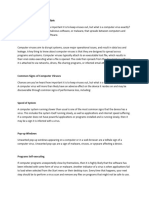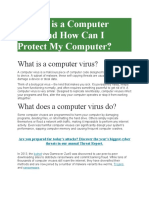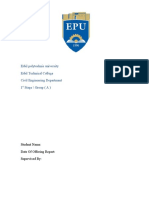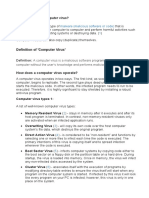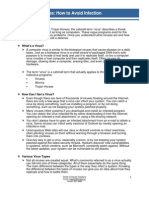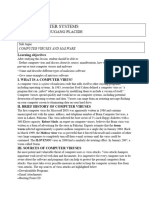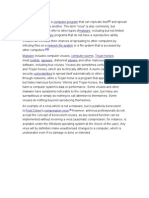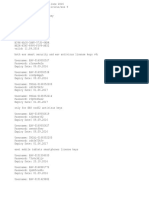Computer Viruses
Uploaded by
prevailduruComputer Viruses
Uploaded by
prevailduruCOMPUTER VIRUSES
A computer virus is a type of malicious software program (malware) that, when executed, can replicate
itself by modifying other computer programs or files and inserting its own code. The primary purpose of a
virus is to disrupt the normal functioning of a computer, steal sensitive information, or cause damage to
files and systems. The virus is often spread through infected files or applications, and it requires a host
program or file to execute.
Viruses can affect computers, smartphones, and other electronic devices, and they can vary in terms of
how they spread and their impact on systems. Unlike other forms of malware, a virus usually requires
human interaction (e.g., opening an infected file or downloading software) to propagate.
Common Types of Computer Viruses
There are several common types of computer viruses, each with distinct methods of infection, replication,
and effects. Below are the most well-known types, along with examples:
File Infector Viruses
These viruses attach themselves to executable files, such as .exe, .com, or .bat files. They spread when the
infected file is executed.
Example: The CIH virus (also known as the Chernobyl virus) is a file infector that targets Windows
systems. It can corrupt files and even erase data on hard drives.
Macro Viruses
Definition: Macro viruses infect the macro functions within applications such as Microsoft Word or
Excel. These viruses are typically spread via infected documents.
Example: The Concept virus is a well-known macro virus that spreads through infected Word documents.
Once a user opens an infected document, the virus executes and spreads to other documents.
Boot Sector Viruses
These viruses infect the boot sector of a computer’s hard drive or removable storage device, such as a
USB flash drive. The virus activates when the computer starts up.
Example: The Stone virus is a boot sector virus that infects the Master Boot Record (MBR) of a
computer. It causes the system to fail to boot normally, and may require reinstallation of the operating
system to remove.
Polymorphic Viruses
Polymorphic viruses are designed to change their code each time they spread, making them difficult to
detect by antivirus software.
Example: The Storm Worm is a polymorphic virus that disguises its true form to avoid detection and can
be spread through email attachments or social media messages.
Resident Viruses
Resident viruses attach themselves to the system’s memory or core functions, making them harder to
detect and remove.
Example: The Randex virus is a resident virus that remains in a computer’s memory and modifies system
files, making it difficult to find and remove.
Non-Resident Viruses
Unlike resident viruses, non-resident viruses rely on a host file to execute their malicious actions. They
are activated when a user runs the infected host program.
Example: The Cascade virus is a non-resident virus that targets early versions of MS-DOS and displays a
visual disruption on the screen, making it visible to the user.
Trojan Horses
Though not technically a virus, Trojan horses are often grouped with viruses. They disguise themselves as
legitimate programs but perform harmful actions when run.
Example: The Zeus Trojan is a malicious program designed to steal personal information, such as login
credentials and banking information.
Worms
Worms are similar to viruses, but they do not require a host file to spread. They replicate and spread
across networks independently.
Example: The Conficker worm spreads by exploiting vulnerabilities in network services. It can infect
millions of computers worldwide by spreading via email and network connections.
How a Computer Gets Infected with Spyware and Computer
Viruses
A computer can become infected with a virus or spyware in various ways. The most common infection
methods include:
Downloading Infected Files
Many viruses are distributed through downloads from unreliable or suspicious websites. When users
download pirated software, cracked programs, or files from untrusted sources, they may unknowingly
download viruses or spyware.
Example: A user might download a free software program that contains a hidden virus.
Opening Infected Email Attachments
Email attachments are one of the most common ways viruses spread. Users may receive emails from
unknown or trusted sources with attachments or links that contain malicious code.
Example: An email disguised as a notification from a legitimate company (e.g., a bank) may contain a
virus embedded in an attachment.
Using Infected USB Drives or External Devices
Viruses can spread through USB flash drives or external hard drives. When an infected USB drive is
plugged into a computer, it can execute and transfer the virus to the host machine.
Example: A user may transfer files from an infected USB stick to their computer, unknowingly spreading
a virus.
Visiting Malicious Websites
Certain websites are designed to automatically infect visitors with viruses or spyware. These websites
often use "drive-by downloads," which automatically download and install malware without the user’s
consent.
Example: A user may visit a site that appears legitimate but is designed to infect the system with
malicious software.
Peer-to-Peer (P2P) File Sharing
Files shared through P2P networks, such as torrents, may contain viruses or spyware. When users
download files from these networks, they can accidentally download harmful programs.
Example: A file sharing a popular movie might actually contain a virus.
Social Engineering and Phishing Attacks
Social engineering attacks trick users into executing a virus or downloading spyware. In a phishing attack,
cybercriminals impersonate trusted entities (banks, social media, etc.) to deceive the user into revealing
personal information or clicking on a malicious link.
Example: A phishing email might contain a link to a fake website that asks users to input sensitive
information, leading to a spyware infection.
How to Prevent Computer Virus Infection
Use Reliable Antivirus Software
Installing reputable antivirus software can help detect and remove viruses before they cause damage.
Regularly updating the antivirus software ensures that it remains effective against new threats.
Example: Popular antivirus software includes Norton, McAfee, and Kaspersky.
Avoid Downloading Files from Untrusted Sources
Never download files from unknown websites or unverified sources. Always check the credibility of the
source before downloading anything.
Example: Only download files from official software websites or trusted app stores.
Keep Software and Operating Systems Updated
Regular software updates fix security vulnerabilities and patch weaknesses in the operating system that
could be exploited by viruses. Enabling automatic updates ensures your system is always protected.
Example: Regularly updating Windows, macOS, or any other operating system helps prevent infections
from viruses targeting known vulnerabilities.
Avoid Clicking on Suspicious Links or Attachments
Do not open email attachments or click on links from unknown senders. Even if the email appears to be
from a trusted source, verify its legitimacy before interacting with any links or attachments.
Example: If you receive an unexpected email from a bank, do not click on the link; instead, visit the
bank’s official website directly.
Use Firewalls
A firewall acts as a barrier between your computer and potentially harmful external traffic. It helps block
unauthorized access and can prevent viruses from spreading through your network.
Example: Enabling a personal firewall on your computer can help prevent viruses from entering your
system via the internet.
Avoid Peer-to-Peer (P2P) File Sharing
P2P file-sharing applications can expose your computer to malware. It is safer to use legitimate services
for downloading or sharing files.
Example: Instead of using torrent sites to download software, opt for trusted software distribution
platforms.
Backup Important Files Regularly
Backing up important data ensures that even if your system gets infected, you won’t lose valuable files.
Store backups on an external drive or cloud storage.
Example: Regularly backup important documents, photos, and project files to external storage.
Virus Detection and Cleaning
Antivirus Scans
Antivirus programs can scan your system for viruses, spyware, and other forms of malware. Most
antivirus tools allow for full system scans, which check every file and program for potential threats.
Example: A full scan using Kaspersky antivirus could detect a virus hiding in system files.
Manual Virus Removal
In some cases, antivirus software may not be able to remove a virus, especially if it is deeply embedded in
system files. In such cases, you may need to remove the virus manually, which may involve booting into
safe mode or using specialized virus removal tools.
Example: Using tools like Malwarebytes or AdwCleaner, which specialize in detecting and removing
stubborn malware.
Reinstall the Operating System
If the virus has severely corrupted the system, reinstalling the operating system can remove all traces of
the virus. Ensure that you back up important files before reinstalling.
You might also like
- Unit 3 Developing Secure Information Systems-1No ratings yetUnit 3 Developing Secure Information Systems-114 pages
- Computer Viruses Types of Viruses Use of Antivirus - WPS OfficeNo ratings yetComputer Viruses Types of Viruses Use of Antivirus - WPS Office6 pages
- Eden Solomon Computing Science AssignmentNo ratings yetEden Solomon Computing Science Assignment7 pages
- Ethical - Hacking-1 (Islamic University of Science and Technology Pulwama)No ratings yetEthical - Hacking-1 (Islamic University of Science and Technology Pulwama)37 pages
- Introduction To Computer: Semester: BS 5 Environmental SciencesNo ratings yetIntroduction To Computer: Semester: BS 5 Environmental Sciences22 pages
- What Is A Computer Virus and How Can I Protect My ComputerNo ratings yetWhat Is A Computer Virus and How Can I Protect My Computer4 pages
- Erbil Polytechnic University Erbil Technical College Civil Engineering Department 1 Stage / Group (A)No ratings yetErbil Polytechnic University Erbil Technical College Civil Engineering Department 1 Stage / Group (A)6 pages
- Computer Memory Networks Security Arpanet Antivirus Programs Programs Computer SystemNo ratings yetComputer Memory Networks Security Arpanet Antivirus Programs Programs Computer System6 pages
- Program Security (Final Report in ITE185)-1No ratings yetProgram Security (Final Report in ITE185)-114 pages
- Computer Viruses: How To Avoid InfectionNo ratings yetComputer Viruses: How To Avoid Infection6 pages
- Introduction To Computer Software and HardwareNo ratings yetIntroduction To Computer Software and Hardware11 pages
- Computer Program Malware Adware SpywareNo ratings yetComputer Program Malware Adware Spyware18 pages
- Computer Viruses Exposed: No More Infections: Beat Malware, Adware, And Spyware Now!From EverandComputer Viruses Exposed: No More Infections: Beat Malware, Adware, And Spyware Now!No ratings yet
- Computer Assembly and Repair Lab Manual 2023 202 - 231209 - 093922No ratings yetComputer Assembly and Repair Lab Manual 2023 202 - 231209 - 09392263 pages
- Brainvision Recorder: Software Version) & +& ( ( (+No ratings yetBrainvision Recorder: Software Version) & +& ( ( (+242 pages
- Ultimate Managed Services Pricing Guide 1No ratings yetUltimate Managed Services Pricing Guide 110 pages
- Cybersecurity Category Interview QuestionsNo ratings yetCybersecurity Category Interview Questions71 pages
- Fighting Fake Antivirus Software: What Is An Antivirus?No ratings yetFighting Fake Antivirus Software: What Is An Antivirus?1 page
- Information Technology Objectives: Multiple Choice Questions100% (2)Information Technology Objectives: Multiple Choice Questions13 pages
- NSS Labs Enterprise Endpoint Comparative Report ExploitsNo ratings yetNSS Labs Enterprise Endpoint Comparative Report Exploits5 pages
- A Literature Review On Malware and Its AnalysisNo ratings yetA Literature Review On Malware and Its Analysis13 pages
- WatchGuard-Threat-Report-Q1-2019_smallerNo ratings yetWatchGuard-Threat-Report-Q1-2019_smaller35 pages
- Computer Viruses Types of Viruses Use of Antivirus - WPS OfficeComputer Viruses Types of Viruses Use of Antivirus - WPS Office
- Ethical - Hacking-1 (Islamic University of Science and Technology Pulwama)Ethical - Hacking-1 (Islamic University of Science and Technology Pulwama)
- Introduction To Computer: Semester: BS 5 Environmental SciencesIntroduction To Computer: Semester: BS 5 Environmental Sciences
- What Is A Computer Virus and How Can I Protect My ComputerWhat Is A Computer Virus and How Can I Protect My Computer
- Erbil Polytechnic University Erbil Technical College Civil Engineering Department 1 Stage / Group (A)Erbil Polytechnic University Erbil Technical College Civil Engineering Department 1 Stage / Group (A)
- Computer Memory Networks Security Arpanet Antivirus Programs Programs Computer SystemComputer Memory Networks Security Arpanet Antivirus Programs Programs Computer System
- Computer Viruses Exposed: No More Infections: Beat Malware, Adware, And Spyware Now!From EverandComputer Viruses Exposed: No More Infections: Beat Malware, Adware, And Spyware Now!
- Computer Virus: The Damaging Facts About Computer Viruses!From EverandComputer Virus: The Damaging Facts About Computer Viruses!
- Computer Assembly and Repair Lab Manual 2023 202 - 231209 - 093922Computer Assembly and Repair Lab Manual 2023 202 - 231209 - 093922
- Brainvision Recorder: Software Version) & +& ( ( (+Brainvision Recorder: Software Version) & +& ( ( (+
- Fighting Fake Antivirus Software: What Is An Antivirus?Fighting Fake Antivirus Software: What Is An Antivirus?
- Information Technology Objectives: Multiple Choice QuestionsInformation Technology Objectives: Multiple Choice Questions
- NSS Labs Enterprise Endpoint Comparative Report ExploitsNSS Labs Enterprise Endpoint Comparative Report Exploits




